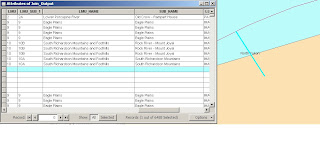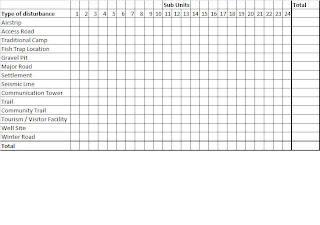yt_planning_regions_250k
This layer outlines the administrative divisions of the entire Yukon Territory, as shown in the image below.

nypr_lmu_mar08
This layer outlines the landscape management units (LMU) specific to the North Yukon administrative region. "LMUs are distinct areas of land that have similar ecological properties (landform and vegetation) or were previously delineated (e.g. Old Crow Flats SMA). The borders of the units are usually drawn around rivers, roads, existing SMAs or identifiable features. LMUs are intended to form the spatial framework for cumulative effects monitoring" (Metadata NYLMU, 2008). There are 13 different LMUs in the given region, as shown in the image below. For the sake of this project, measurements of landscape fragmentation will be made according to the region's 24 sub-units.

nypr_linear_features_50k
This layer shows linear features present in the North Yukon region. Linear features include: access roads (AR), main roads (MR), national roads (roads), seismic lines (SL), trails(TR) and winter roads (WR). This layer was used to measure linear density in the Eagle Plain study area as well as for the entire North Yukon Region. Buffers were not added to these features as width is not taken into consideration when measuring linear density. The image below shows these linear features along with the previous layers. The Eagle Plain study area, where the highest concentration of land use disturbance is found, is outlined in black.

ny_footprint and "footprint without buffers"
This layer is very similar to the previous layer, only that it includes all linear and non linear land use footprints. Effective mesh size measurements was based on the "footprint without buffers" layer, whereas the "ny_footprint" was used to measure surface disturbance. Further manipulation of this data will be discussed below when describing the "Union FG1" and "Union FG2" layers.
NY_LT_2005 & NY_LTRC_2005
This layers is a raster biophysical map for the NY. ''Landscape types were classified and mapped through the NY Biophysical Mapping Project using a predictive modeling approach. The NY biophysical map currently contains 18 district landscape types and 10 seral types for a total of 28 biophysical units" (NYLTRC metadata, 2005). For the purpose of setting criteria for the fragmentation geometries (FG), I initially wanted to create a layer for all water bodies. Unfortunately, given the time constraints I am limiting the analysis to two FGs. However, it may become useful if more FGs are to be included.
Join_Output
In order to measure linear density for both the Eagle Plain study area and the entire North Yukon Region, a spatial join was needed to join attributes from the "nypr_linear_features_50k" and the "nypr_lmu_mar08" layers. As a result, the majority of the linear features were associated with a sub unit, thus facilitating the linear density calculation. However, some features were not associated with any sub unit in the table, despite them being located within a sub unit when selected. This issue will be further discussed in a later section. (I suspect that when a linear feature crosses a sub unit boundary the table cannot compute where the feature is located since it is present in more than one sub unit. The image below shows an access road that crosses the "Rock River - Mount Joyal" and the "South Richardson Mountains" sub unit border. It will be interesting to see whether or not it is possible to cut these features along borders in order to get an accurate measurement of linear features for every sub unit. Overall, 240 individual features representing a total length of 1390.39 km were not associated with one individual sub unit. This discrepancy has no impact on the linear density calculation for the entire North Yukon Region. However, it will likely skew the results for the Eagle Plain study area as there are several features that cross over into adjacent sub units.

"Union FG1" and "Union FG2"
A union of the "nypr_lmu_mar08" and "ny_footprint" was necessary to run the effective mesh size tool effectively. In "Union FG1", all land use footprints along with the 24 sub units are present in the attributes table. "Union FG2" is similar, only seismic lines have been removed in order to measure the second FG. In both cases, sub units were given a value of 1 in the "patch" column in the attributes table, whereas disturbances were given a value of 0 (see image below).

Patch Size FG 1 (x2) and Patch Size FG 2 (x2)
These four layers are the result of running the effective mesh size tool for both fragmentation geometries. For each FGs, one of the layers displays the cross-boundary procedure (CBC) and another displays the CUT procedure. Identical value ranges were used for both FGs in order to compare differences between FGs. For both the CBC and CUT procedures, values were divided into 6 classes and colors range from red (more fragmented) to green (less fragmented). The image below is a representation of the effective mesh size (CBC) for FG 1.






